15 Best OKR Software
Imagine managing a rapidly expanding company with teams dispersed across
Imagine managing a rapidly expanding company with teams dispersed across departments and locations and priorities that change frequently. Maintaining alignment is essential to the mission, not just a nice-to-have. Actually, there is a 42% higher chance of peak performance for businesses with structured goal frameworks. At that point, OKR software turns into your alignment engine rather than merely a tool. This guide examines the top 15 OKR software choices that are influencing goal management in the future so you can select the one that will support your next stage of development.
A new generation of intelligent, user-friendly platforms designed for scale, agility, and transparency will emerge in 2025 as the OKR landscape continues to change quickly.
In today’s rapidly evolving business ecosystem, success hinges on more than just hard work—it demands precision, alignment, and adaptive strategy. Datalligence emerges as a game-changer from the 15 Best OKR Software that transforms how organizations conceptualize, track, and achieve their most ambitious goals.

Datalligence leverages cutting-edge technologies to deliver an unparalleled goal management experience:
By implementing Datalligence, organizations can expect:
Datalligence is more than software,it’s a strategic partner in your organizational success journey. By bridging the gap between strategy and execution, we empower teams to turn ambitious visions into tangible results.
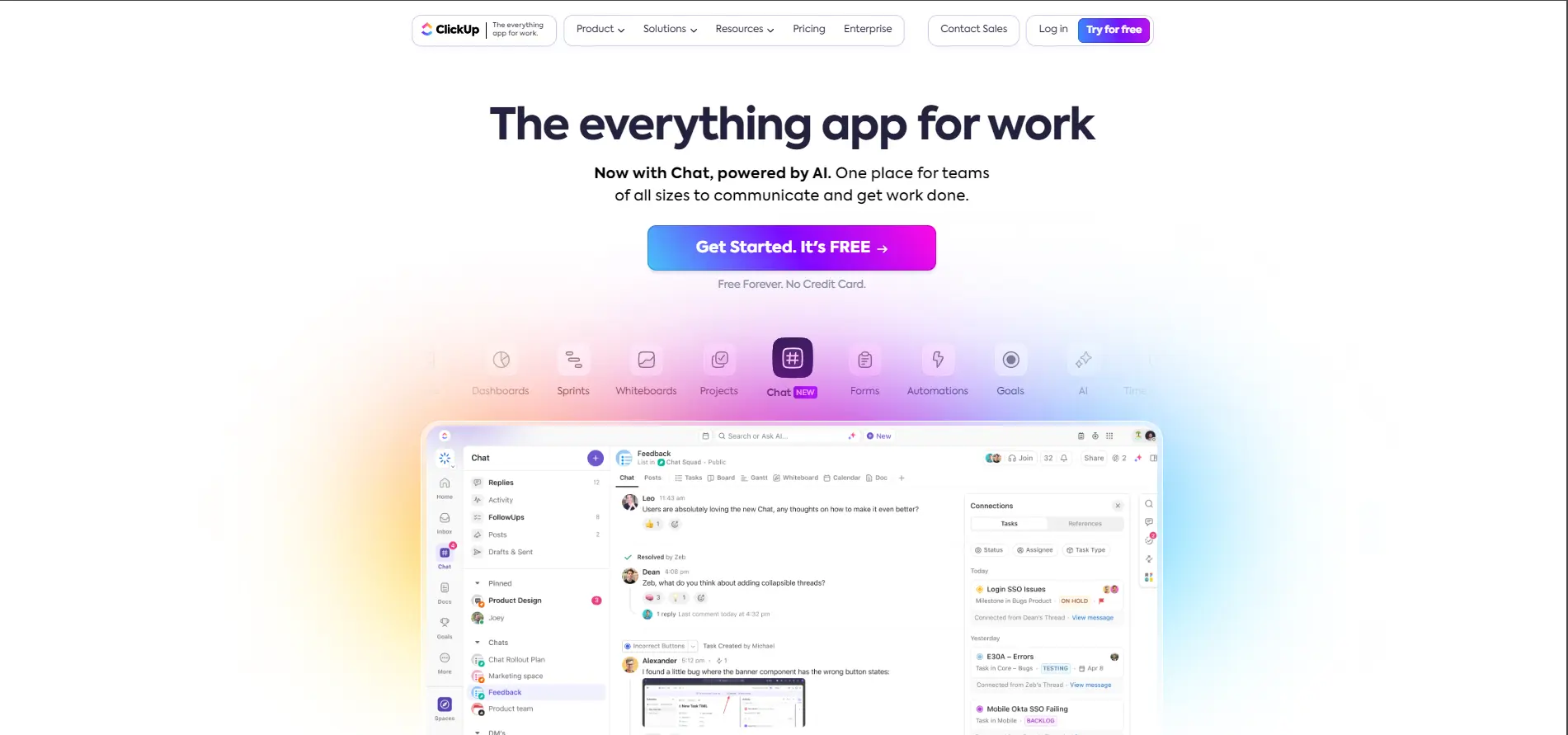
ClickUp is one in the realm of 15 best OKR software, celebrated for its versatility across various industries. Its platform is designed to enhance performance management through advanced features tailored for remote team management. Teams can set strategic objectives and track progress with ease, ensuring transparency and effective management across all levels of the organization.
ClickUp’s approach to OKR management not only streamlines the setting and tracking of objectives but also enhances the overall strategic execution within organizations. Its broad range of features and templates makes it a formidable tool in the arsenal of any team aiming to achieve high performance and alignment.

Profit.co is one of the 15 best OKR software landscape, offering a comprehensive suite designed to enhance goal setting, tracking, and execution. With a user-friendly interface, the software enables clear definition of objectives and measurable key results, fostering shared team ownership and full alignment across individual and departmental goals. This integration of OKR management with performance, task management, and employee engagement tools makes Profit.co a holistic solution for modern enterprises.
Profit.co’s commitment to continuous software improvement is reflected in its regular updates and the provision of a 30-day free trial, which allows organizations to assess its capabilities without financial commitment. The platform not only supports operational efficiencies but also contributes to strategic goal achievement, evidenced by its substantial role in helping notable companies realize significant cost savings and performance targets.
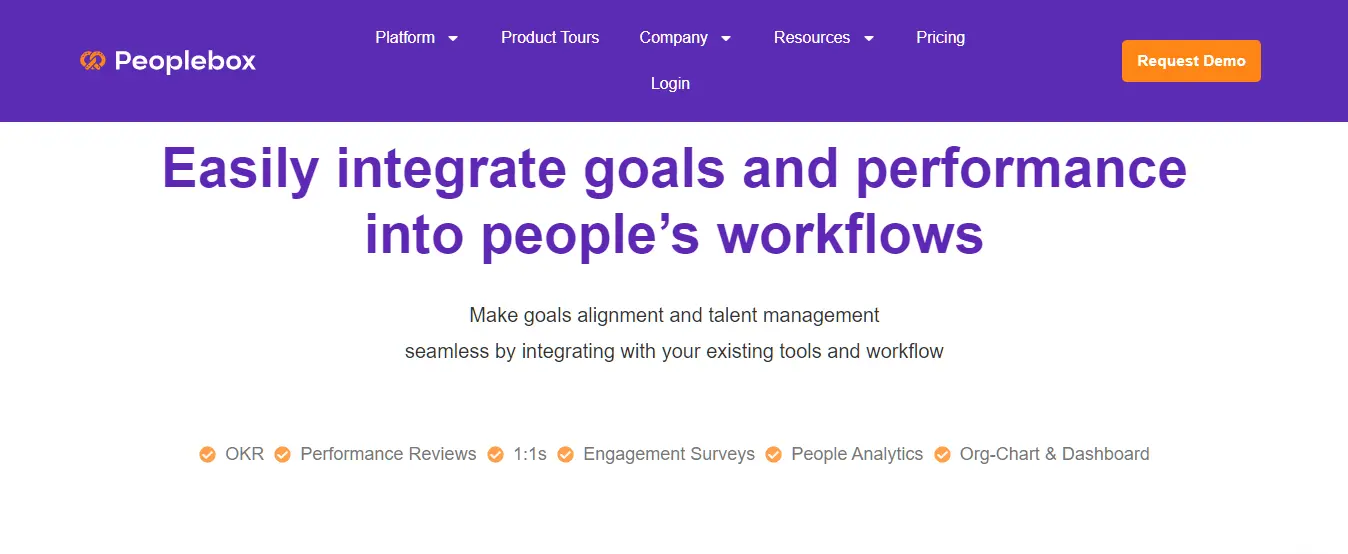
People Box distinguishes itself in the 15 best OKR software market by blending performance management, employee engagement, and people analytics into a cohesive platform. It is especially noted for its ability to integrate OKRs (Objectives and Key Results), a methodology rooted in the practices of industry giants like Intel and Google since the 1970s, which focuses on goal-setting and tracking to drive organizational growth.
People Box supports both top-down and bottom-up OKR alignment, recommending the top-down approach for better strategic coherence. This feature, coupled with its rich resource offerings including case studies, webinars, and the Peoplebox Pulse Newsletter, positions it as a valuable tool for companies aiming to enhance their strategic execution and employee engagement.
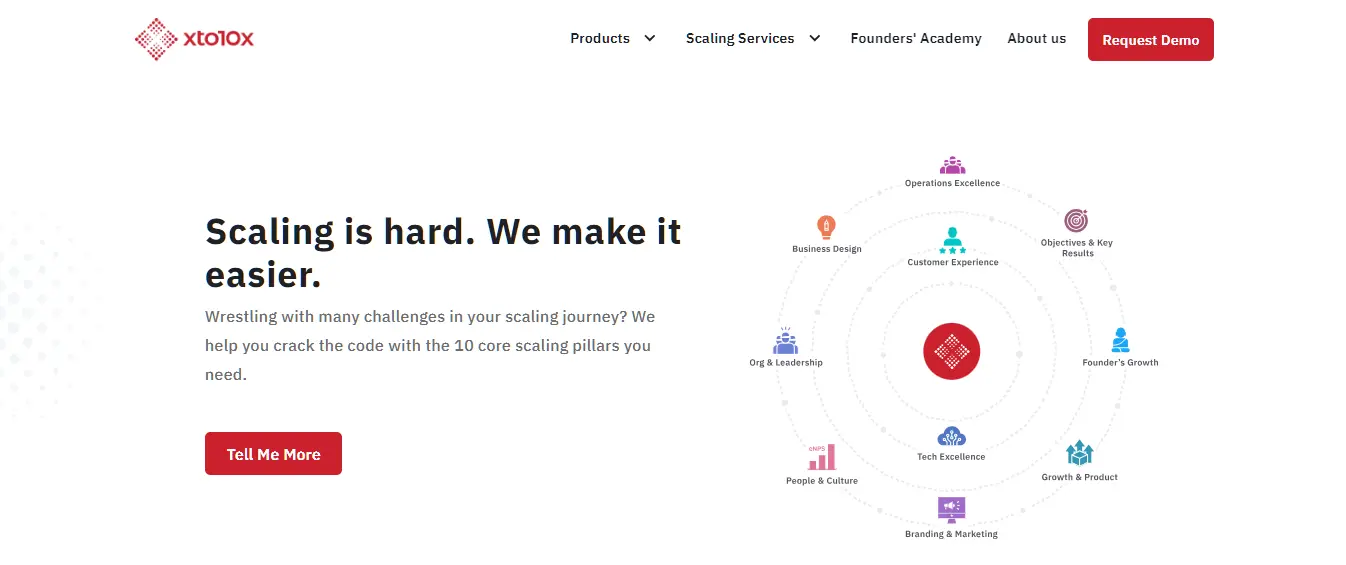
Xto10X is recognized for its comprehensive employee experience platform, known as PeopleCues, which integrates OKR Software, Performance Management, and Employee Engagement tools. The platform is designed to streamline the entire process of goal management from setting to tracking, with a strong focus on aligning individual achievements with broader organizational goals.
Xto10X offers specialized services including OKR Consulting and an OKR Learning Centre to support organizations in implementing and maximizing the benefits of OKRs. The pricing structure is divided into three main plans:
Xto10X continues to be a pivotal tool for businesses looking to foster a culture of transparency, alignment, and enhanced performance through innovative software solutions. The platform’s ability to integrate with multiple business tools and its mobile functionality make it a versatile choice for modern organizations aiming for strategic execution and success.
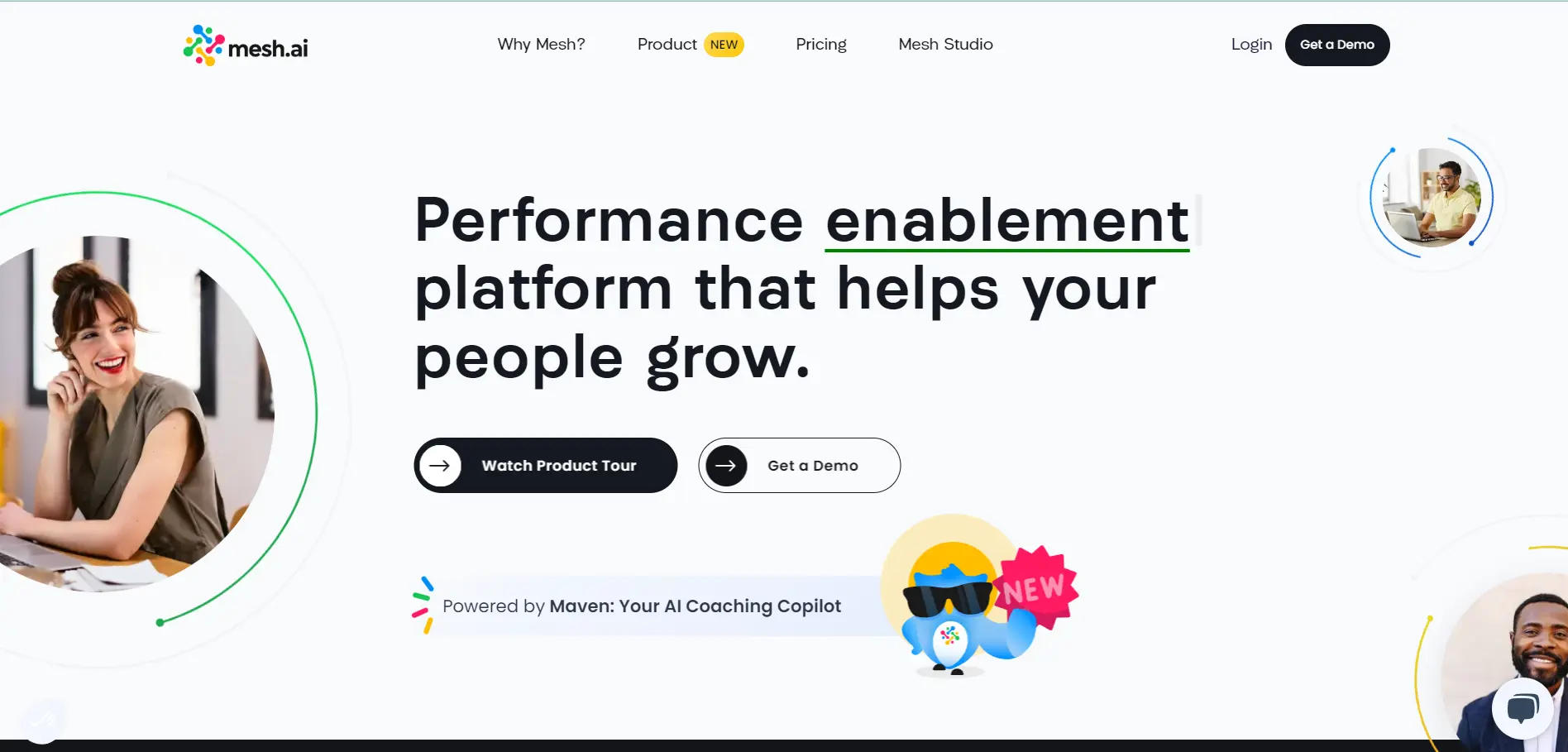
Mesh.ai stands as a transformative force in OKR software, significantly enhancing organizational performance. By leveraging AI-driven user experiences and real-time insights, Mesh.ai not only scales performance practices but also boosts the density of high performers by up to 15%. This platform is designed to foster habit formation through AI nudges, enabling managers to effectively scale their coaching and feedback mechanisms.
Mesh.ai’s structured approach to performance management is evident in its varied pricing plans, catering to different organizational needs from startups to large enterprises. The inclusion of Mesh Maven and the upcoming AI Coaching Copilot further exemplify its commitment to continuous improvement and development.
Mesh.ai seamlessly integrates with existing corporate systems, enhancing workflow continuity without disrupting established processes. It empowers employees to take charge of their growth by engaging in continuous dialogue about competency development, turning managers into super coaches through insightful performance data. The platform’s robust security features ensure compliance with global standards, safeguarding sensitive organizational data.
Overall, Mesh.ai provides a comprehensive toolkit for organizations aiming to 4x their chances of achieving business goals, making it a pivotal asset for companies focused on strategic growth and performance excellence.
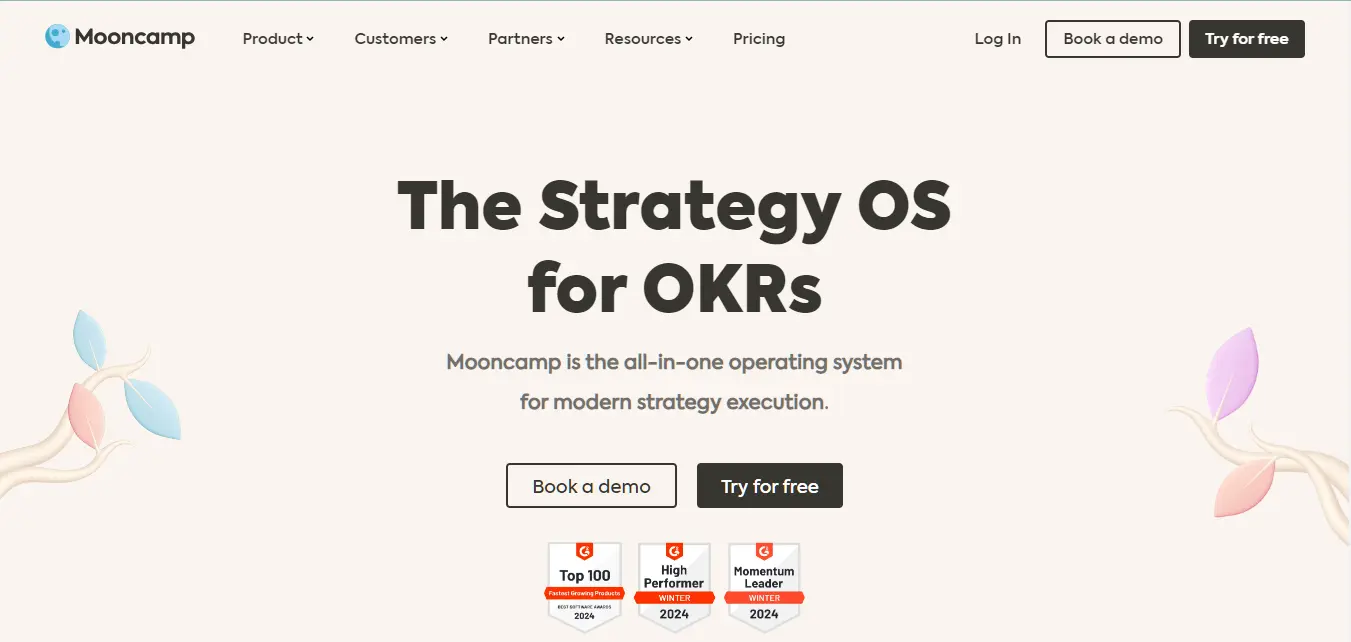
Moon Camp, founded in 2019 and headquartered in Köln, Germany, offers a modern and customizable OKR software that caters to a wide range of businesses, from self-employed individuals to large corporations with over 10,000 employees. Known for its flexibility and enterprise-ready security features, Moon Camp integrates seamlessly with popular platforms like MS Teams, Slack, Jira, Excel, and Asana, enhancing workflow efficiency across diverse operational environments.
Moon Camp’s approach to OKR management is distinguished by its ability to support private OKRs and its integration with both Google & Microsoft SSO or SAML-based SSO, which simplifies user access and enhances security. The platform’s award-winning customer support is available via chat, email, or phone, ensuring users receive assistance whenever needed. This combination of advanced features and dedicated support makes Moon Camp a top choice for businesses aiming to enhance their strategic execution and goal management processes.
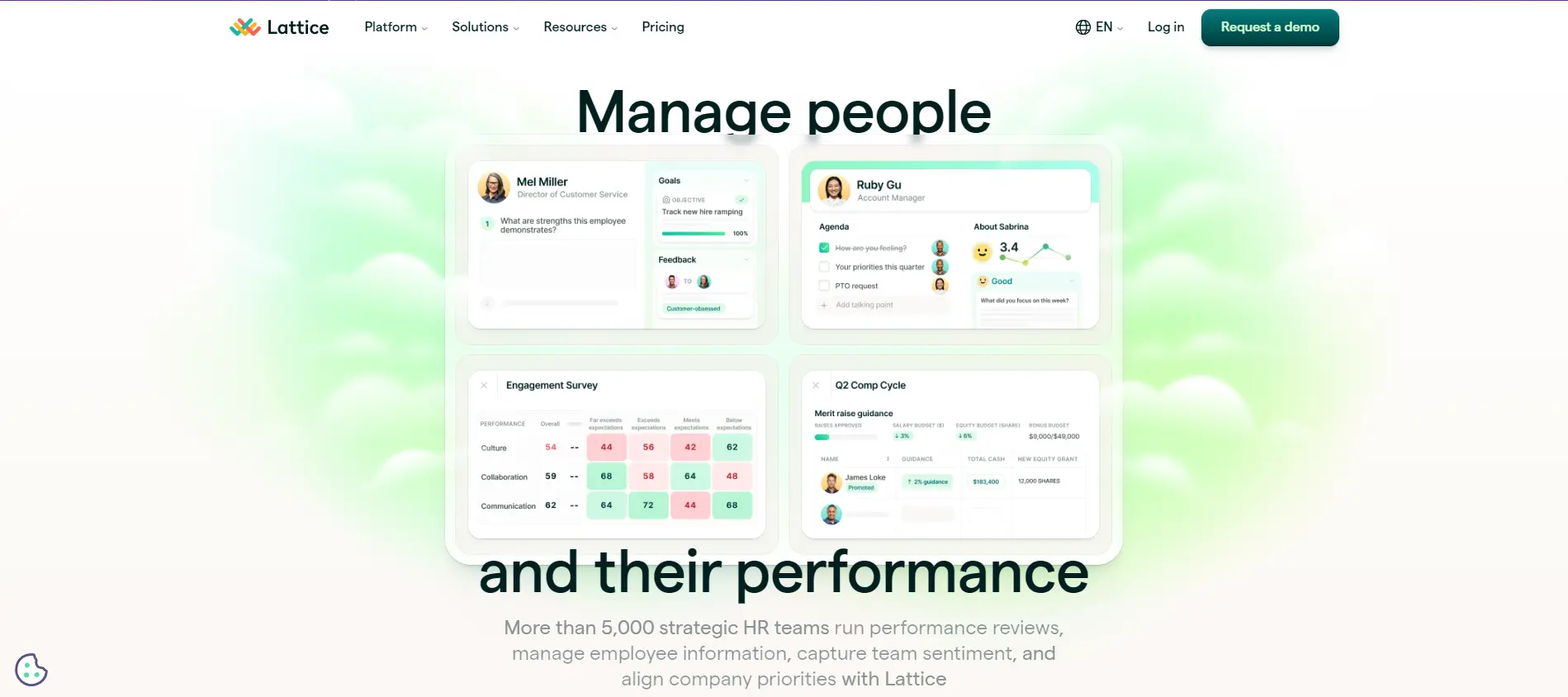
Lattice distinguishes itself in the OKR software market with its comprehensive People Platform, tailored to meet the needs of large teams through a user-friendly interface and advanced features. Serving over 5,000 organizations, Lattice is rated highly with a 4.4 score from 35 ratings, reflecting its robust support and continuous software updates. The platform starts at $11 per person per month, focusing on a holistic experience for talent and learning development without offering a free trial.
Lattice’s OKRs feature stands out by enabling the setting and tracking of transparent objectives that foster collaboration and drive business results. This feature not only allows managers to create team goals, which in turn helps employees align their individual OKRs, but also integrates with various platforms to keep OKRs updated and top of mind. Additionally, Lattice provides resources like “The Complete Guide to OKRs” and “How OKRs Help Teams be More Successful,” which are instrumental in activating employees and accelerating business growth by connecting people success to business success.
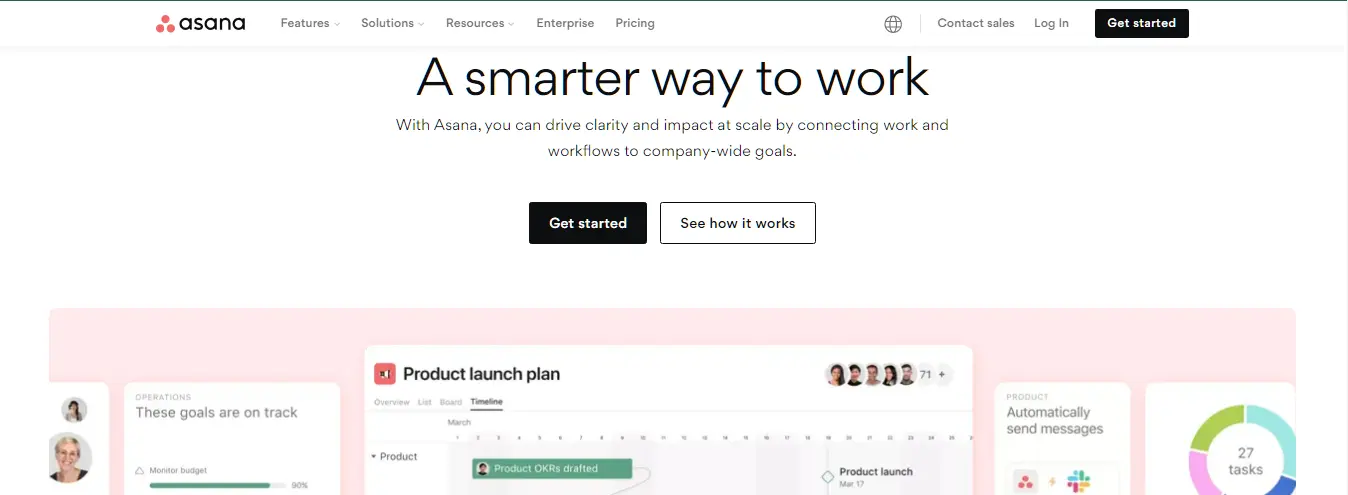
Asana stands out as a comprehensive solution for OKR management, particularly suited for teams in operations, marketing, IT, and leadership. With a high user rating of 4.7, it demonstrates robust capabilities in project management, goal setting, and strategic planning. The platform’s diverse functionalities include extensive project management tools like custom fields and status updates, alongside specialized features for goals and reporting such as dashboards and portfolios.
Asana’s integration capabilities are particularly notable, supporting seamless connections with popular tools such as Slack, Google Drive, and Dropbox, which facilitates an integrated workflow environment.
Asana’s pricing structure caters to a range of user needs, from personal use to advanced business solutions. The platform is noted for its intuitive interface, which simplifies complex projects and strategic planning processes. Asana Goals, a feature available in the Business plan ($25 per user per month), links daily tasks directly to strategic company goals, enhancing alignment and focus across teams.
In terms of collaboration and communication, Asana excels with features such as task comments, project messages, and support for multiple languages, ensuring that team collaboration is efficient and inclusive. The platform’s comprehensive approach to OKR management, combined with its ability to connect daily work to overarching business objectives, positions Asana as a top choice for organizations aiming to streamline their goal-setting and project management processes.
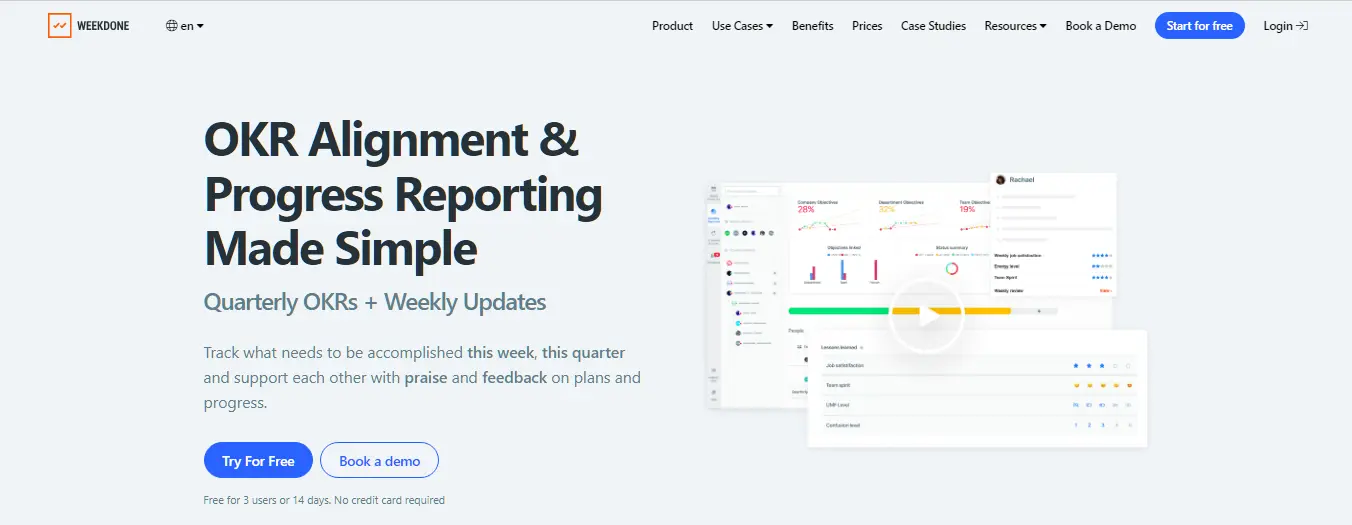
Weekdone is a software development company specializing in OKR (Objectives and Key Results) management, offering solutions that bridge the gap between long-term strategy and daily operations. Their software provides a suite of features designed to enhance strategic execution and team alignment through OKR linking, KPI tracking, and comprehensive project management tools. Key functionalities include weekly planning and reporting, pulse surveys, 1:1 meetings, and team announcements, all aimed at promoting a high level of organizational transparency and focus.
Weekdone positions itself as a tool not just for tracking goals but for fostering an environment where strategic objectives are continuously aligned with operational activities. Its emphasis on privacy, user customization through cookie settings, and mobile app availability for both iOS and Android platforms make it a comprehensive choice for modern organizations aiming to enhance their OKR management processes.
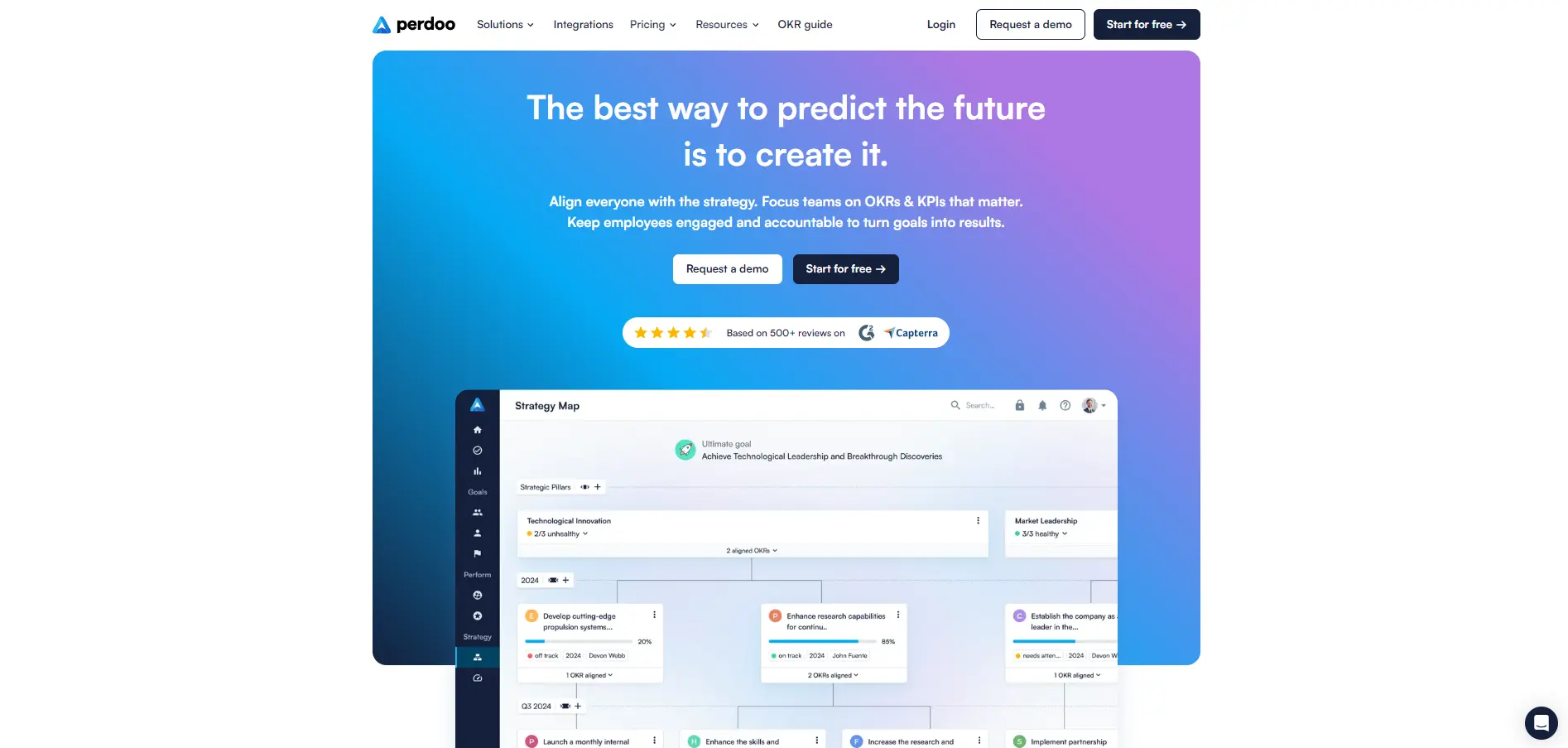
Perdoo is a distinguished player in the OKR software market, designed to simplify the complex process of setting andtracking organizational goals. Its platform is tailored to facilitate strategic alignment across various levels of an organization, ensuring that every team member is focused on achieving common objectives.
Perdoo’s approach to OKR management focuses on enhancing clarity and commitment to organizational goals, which is essential for driving business success. Its integration capabilities with other tools like Slack and Microsoft Teams further streamline workflow and communication within teams.
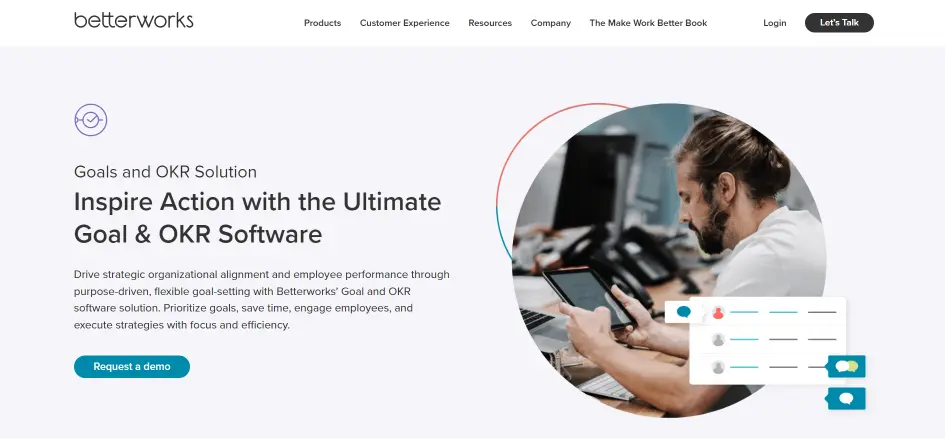
Betterworks stands out as a premier provider of performance management solutions, specializing in enhancing workforce efficiency and elevating employee experiences. Based in Menlo Park, USA, and employing between 51-200 people, Betterworks offers a robust SaaS platform tailored for various organizational needs, including check-ins, feedback, and employee engagement. Its software is designed to cater to businesses of all sizes, making it a versatile tool for any organization looking to improve team synchronization and performance.
Betterworks continues to be a critical tool for companies aiming to foster a culture of continuous improvement and alignment across team goals and organizational objectives. Its extensive features and broad integration capabilities make it an ideal choice for enterprises looking to enhance their performance management strategies.
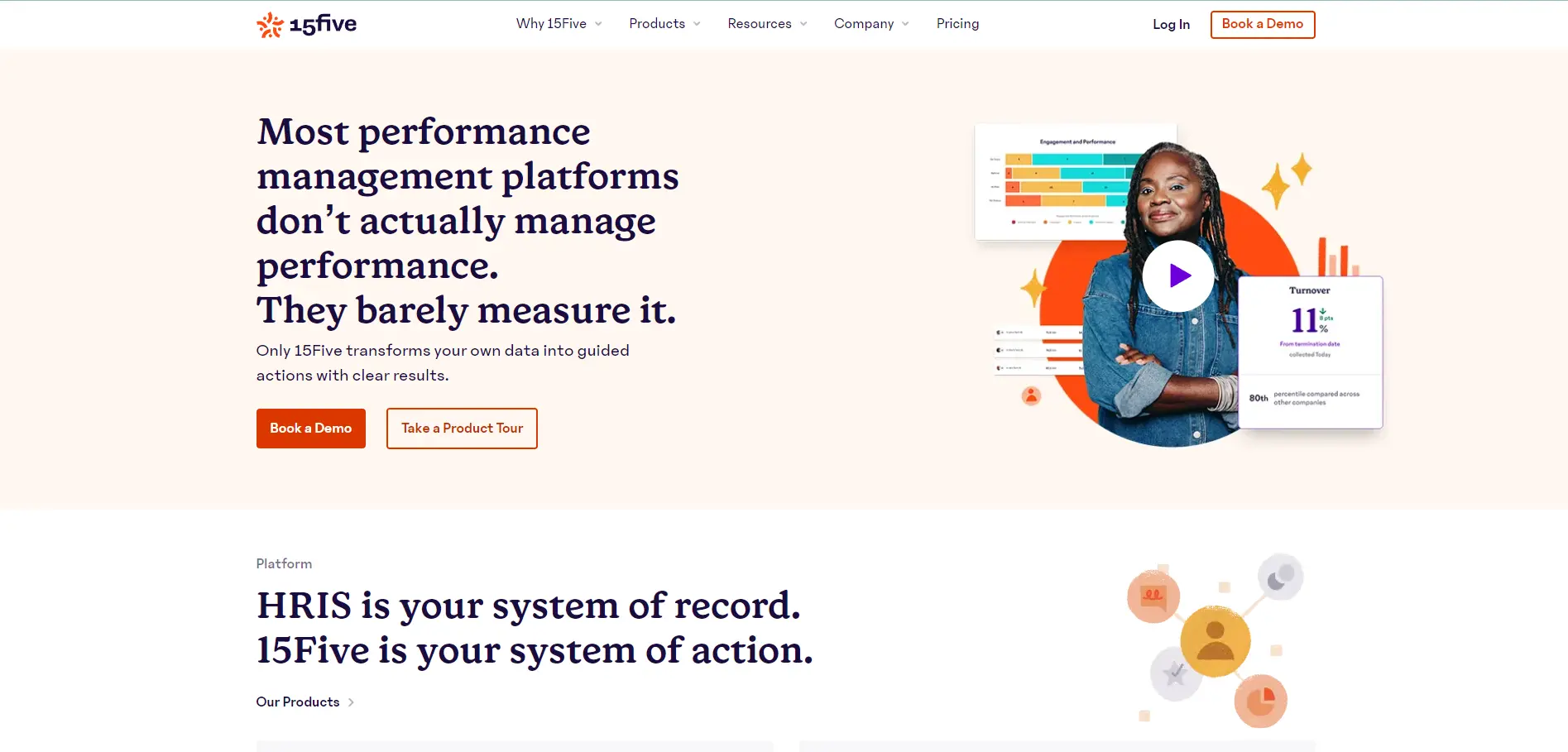
15five is renowned for its innovative approach to performance management, transforming data into actionable insights that lead to clear results. This software integrates seamlessly with HR Information Systems (HRIS), providing a dual system of action and record that enhances organizational operations.
15five continues to stand out as a preferred choice for businesses looking to scale and enhance their performance management strategies through innovative technology and a solid, evidence-based framework.
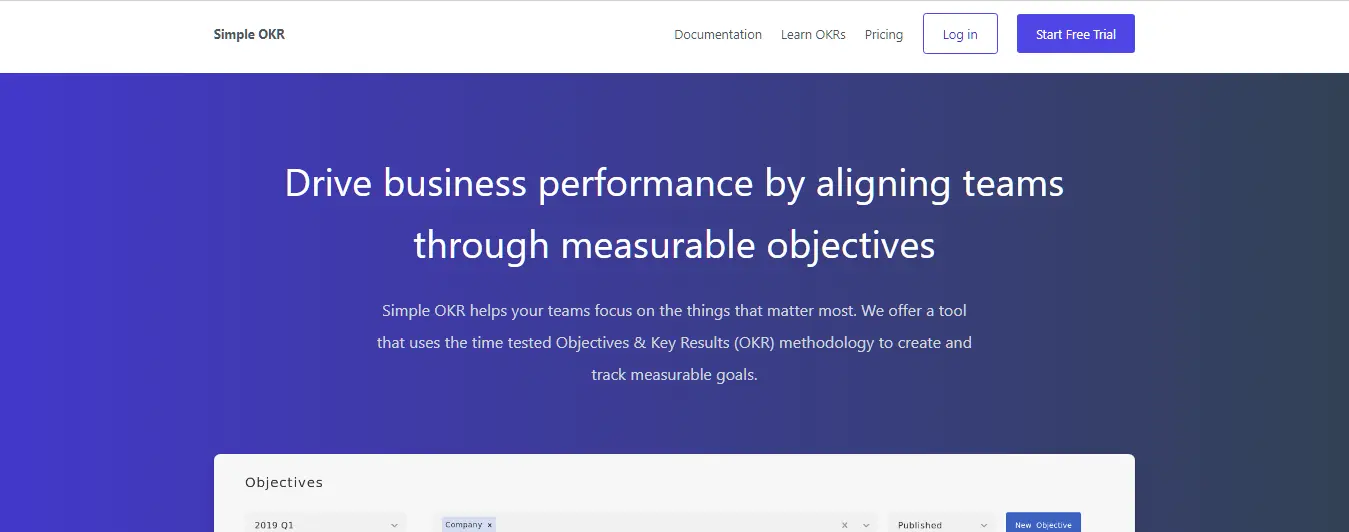
Simple OKR emerges as a notable contender in the OKR software arena, particularly for its core functionality that aligns with the essential needs of modern businesses. It enables organizations to set clear objectives, define measurable key results, and align these objectives with higher-level goals. The platform also offers robust data analytics and reporting tools, which are crucial for monitoring progress and making informed decisions.
Simple OKR offers a free trial, allowing businesses to test its features extensively before committing. Its transparent and tiered pricing plans cater to different business sizes, ensuring that organizations can scale their use of the software as they grow.
In the evolving landscape of 15 best OKR software for 2025, Simple OKR is poised to meet the demands for enhanced collaboration tools, mobile accessibility, and advanced security features, all while ensuring a superior user experience. This positions Simple OKR as a valuable tool for businesses aiming to enhance their strategic execution through effective goal management and alignment.
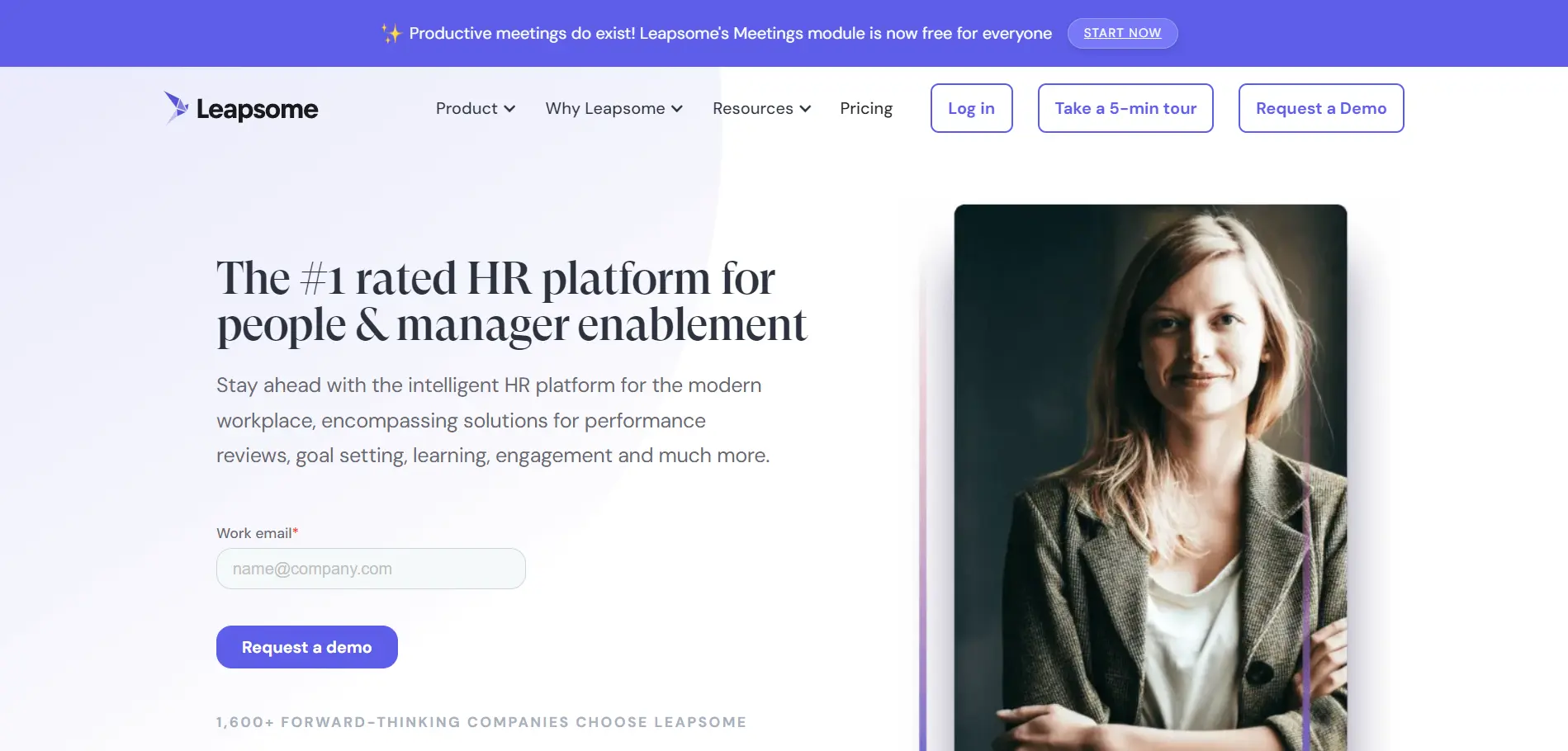
Leapsome has distinguished itself as a leading OKR software solution for 2024, offering a suite of features tailored to bolster organizational alignment, focus, and performance tracking. Amidst the array of platforms explored, Leapsome stands out for its meticulous design, catering to the intricate needs of modern businesses. With a core focus on streamlined goal management, heightened visibility, and transparent progress tracking, Leapsome emerges as a robust tool fostering a culture of continuous improvement and strategic alignment.
Using the right software from the 15 best OKR software comparison is crucial for achieving your company-wide goals and fostering better transparency and goal alignment across all levels of your organization. We hope this article has brought you one step closer to finding the right from the 15 best OKR software for you.
If you’re looking for a comprehensive, easy-to-use Best OKR management system that can cater to your unique needs, consider Datalligence. We’ve designed a platform that makes OKR management a breeze, with features like Goals, Track Progress, and Dashboards. With Datalligence, you’ll have a reliable partner that helps you set strategic objectives aligning with your company’s overall goals.
Dharma AR2025-07-07T08:04:20+00:00July 6, 2025|Objectives and Key Results|
Imagine managing a rapidly expanding company with teams dispersed across
Dharma AR2025-06-29T12:54:35+00:00June 27, 2025|General, Objectives and Key Results|
Lattice is a renowned platform that combines performance management
Dharma AR2025-06-29T13:40:52+00:00June 25, 2025|Objectives and Key Results|
Consider adopting Objectives and Key Results (OKRs), a powerful goal-setting framework that promotes alignment and efficient progress tracking. However, implementing OKRs can be challenging, leading many organizations to face difficulties.
Dharma AR2025-06-29T13:48:11+00:00June 24, 2025|Objectives and Key Results|
According to research, people who set clear goals are 42%
Dharma AR2025-05-26T05:32:14+00:00May 22, 2025|Performance Management|
As a business owner or manager, you already know that
Dharma AR2025-05-15T09:21:09+00:00May 14, 2025|Performance Management|
Performance management is the backbone of a high-performing organization, ensuring
Dharma AR2025-05-14T06:28:13+00:00May 14, 2025|General, Performance Management|
Employees want more than just a paycheck; they want
Dharma AR2025-05-13T08:09:25+00:00May 12, 2025|General, Objectives and Key Results|
In an era where digital evolution is no longer
Dharma AR2025-05-13T07:25:09+00:00May 11, 2025|Objectives and Key Results|
Toward the end of every OKR period, every individual and
Dharma AR2025-05-06T10:52:33+00:00May 3, 2025|Objectives and Key Results|
In the fast-paced world of product development, keeping everyone
In the fast-paced world of product development, keeping everyone on the same page is paramount. One of the most effective tools used by organizational goal setting to align their teams and drive productivity is OKRs. When product teams can align their OKRs with overarching company goals, it ensures that every effort, feature, and sprint contributes to the organisational goal setting
In this blog, we’ll delve into how to set product OKRs that synchronize perfectly with your company’s ambitions, ensuring that your product team OKRs are not just a checklist but a strategic roadmap.
At their core, product OKRs are all about aligning the product’s mission and vision with the company’s broader objectives. While the term may sound technical, it’s a straightforward principle:
For instance, if an objective is to “Enhance User Engagement in the Mobile App”, a key result could be “Increase monthly active users by 25% in the next quarter”.
Product OKRs offer a strategic compass for product teams, guiding them toward impactful outcomes and ensuring alignment with organisational goal setting.
Product managers are at the nexus of translating vision into actionable roadmaps. For them, the strategic clarity that OKRs offer is indispensable. Diving deeper, here are the specific reasons why OKRs are essential for product managers:
Setting Product OKRs that are in harmony with your company’s goals is pivotal for ensuring that product strategies and actions cater to the broader organizational objectives. Here’s a step-by-step guide on how to do it, supplemented with examples:
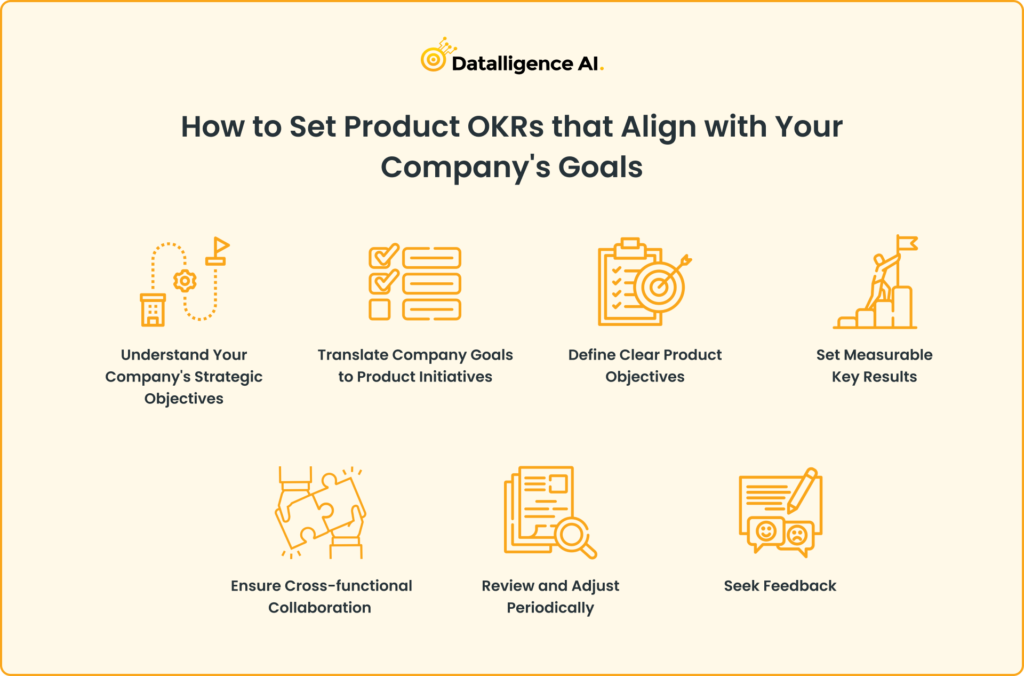
1. Understand Your Company’s Strategic Objectives:
Before setting any Product OKRs, it’s essential to grasp your company’s primary objectives for the upcoming period. Whether it’s expanding into new markets, increasing customer retention, or driving revenue growth, understanding these goals is crucial.
Example: If the company’s goal is to expand into the Asian market, a related product objective might be to localize the product for specific Asian languages or to develop features catering to regional needs.
2. Translate Company Goals to Product Initiatives:
Identify how your product can support or drive the company’s objectives. Break down the broader goals into product-centric strategies.
Example: For a company goal centered on customer retention, a product initiative might be enhancing user experience or adding features that have been frequently requested by existing users.
3. Define Clear Product Objectives:
Based on the identified product initiatives, define clear, actionable, and inspiring product objectives.
Example: “Enhance the mobile user experience to increase user engagement and retention.”
4. Set Measurable Key Results:
For each product objective, define quantifiable key results that would indicate the objective’s success. These should be specific and time-bound.
Example: For the objective of enhancing mobile user experience:
5. Ensure Cross-functional Collaboration:
Product goals often overlap with functions like marketing, sales, and customer support. Engage with these teams to ensure alignment and to set complementary OKRs.
Example: If the product’s key result is to launch a new feature, the marketing team could have a related key result centered around promoting this feature to the user base.
6. Review and Adjust Periodically:
Set regular check-ins (like quarterly reviews) to assess the progress of your Product OKRs and make necessary adjustments in response to changing circumstances or new insights.
Example: If midway through Q2, you realize that the mobile app crash rate isn’t decreasing as expected, you might need to reprioritize certain tasks or allocate additional resources to address the issue.
7. Seek Feedback:
Once your OKRs are set, gather feedback from team members and other stakeholders. This not only ensures buy-in but can also provide valuable insights that might refine your OKRs further.
Example: Developers might provide feedback about the technical feasibility of certain key results, prompting a more realistic revision.
Setting Product OKRs that align with company goals can be immensely beneficial, but the process isn’t without its challenges.
Here are some of the common challenges faced by organizations:
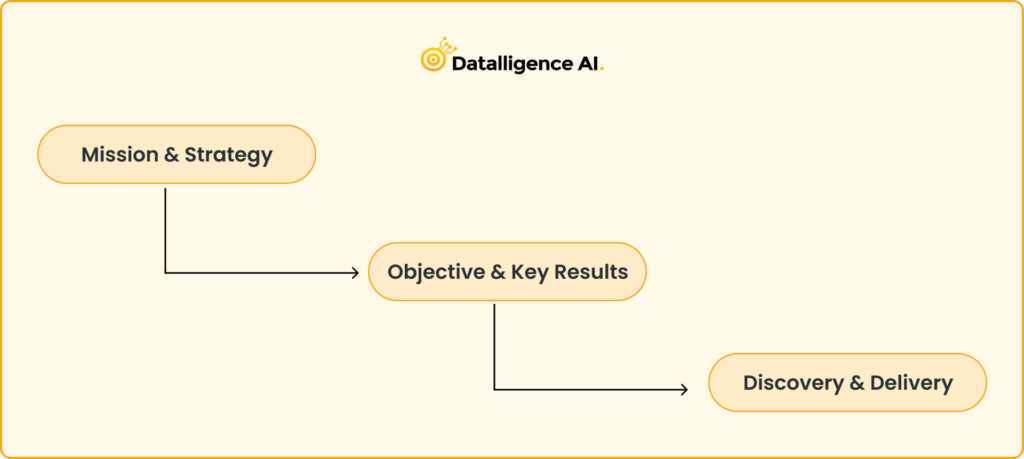
No, Product OKRs and Product Roadmaps are not the same, though they complement each other in the product management realm.
Product OKRs are a goal-setting framework used to define and measure what needs to be achieved in a specific time frame. They focus on high-level objectives and the measurable results that indicate progress towards these objectives.
For example, an OKR might be set as
Objective: Enhance user engagement on our mobile app.
Key Result: Increase daily active users by 20% over the next quarter.
Learn more about Product Management OKR Examples in our Latest Blog.
On the other hand, a Product Roadmap is a strategic document that outlines the sequence of actions or features that the team plans to implement over time. It provides a visual representation of the product’s direction, detailing what features will be built, improved, or removed, and when. Using the above OKR as a context, a section of the roadmap might list:
In essence, while Product OKRs set the ‘what’ and ‘why’ behind a product’s goals, the Product Roadmap provides a clearer picture of ‘how’ and ‘when’ these goals will be approached or realized. OKRs might motivate a team to reach a particular outcome, but the roadmap offers the strategic path and steps to achieve that outcome.
Wrapping Up:
Setting product OKRs that align with organisational goal setting requires thoughtful effort, cross-departmental collaboration, and regular reflection. However, when done right, they can act as a powerful catalyst, driving both the product and the company towards unprecedented success.
In Conclusion, Achieving alignment and clarity in OKRs can sometimes feel overwhelming, but it doesn’t have to be. Datalligence, our OKR software, streamlines this process, offering intuitive tools and insights to help teams set, monitor, and achieve their OKRs. Whether you’re just starting with OKRs or looking to refine your approach, Datalligence ensures that your product goals are always in harmony with your company’s vision.